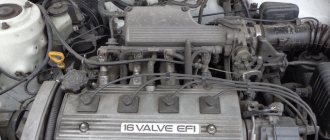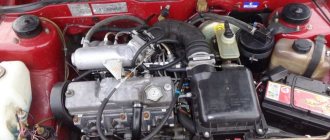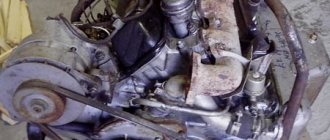In 1976, the VAZ plant began mass production of the new “sixth” model of the car with rear-wheel drive. This car was in many ways similar to the “third” model, but was positioned as more prestigious and dynamic. This was achieved by using the 2106 engine, which had a cylinder capacity increased to almost 1.6 liters and higher power and torque values.
Thanks to its high power, the engine turned out to be suitable for use in the off-road Niva model 2121. Partly due to this, this engine turned out to be the longest-lived power unit of the “classic” family. Today, production continues of several modifications of engines created using the “six” engine block.
Main differences
The design of the new engine was based on solutions tested on already produced VAZ power units. The main difference was the block, in which the cylinder diameter was increased by 3 mm. At the same time, the height of the counterweights on the crankshaft remained similar to the one and a half liter engine of the “third” model.
Due to the increase in volume, the power characteristics of the 2106 engine increased slightly to 80 horsepower. Mated to the engine was a four-speed gearbox with specially selected gears. Thanks to it, the car could reach a speed of 152 km/h, which was a very good indicator at that time.
The applied method of increasing volume has been used by designers before. This is exactly how the “eleventh” 1.3-liter engine was created based on a slightly bored block of the very first Tolyatti 1.2-liter unit.
The most common breakdowns of the sixth engine
Car owners most often encounter the following defects in engine operation:
- The internal diameter of the cylinder increases by 0.15 mm after traveling more than 5 thousand km. This defect occurs if the engine lubricant is not replaced in a timely manner.
- The camshaft is worn out.
- Sound effects in the form of tapping in the engine. This defect can be eliminated by adjusting the valves and replacing the fuel with higher octane fuel. If these measures do not help, then you need to contact the nearest service station, where the pistons and connecting rod bearings will be diagnosed and repaired.
- Oil pressure drops. In this case, the lubricant does not reach the rubbing surfaces, as a result of which the friction force increases, causing the gaskets to burn out, accelerated wear of the working parts, and the device becomes unusable.
- Creaks indicate a breakdown in the timing chain tensioner, damper or pump bearing.
- If the engine stalls while driving, you need to look into the ignition or power systems.
- The engine turns off at idle when there is a failure in the idle speed or air damper adjustments.
- Engine trouble, with this defect it is necessary to adjust or replace burnt valves and cylinder head gasket. The cause of tripling can also be fuel with a low octane number.
Engine block
The main part of the engine is the cylinder block, cast from cast iron along with the lower part of the crankcase. This part contains seats for five supports of the main engine shaft. The lower support covers are processed together with the crankcase and are not interchangeable with each other. The design of all bearings uses replaceable liners with thin walls made of a special alloy. The ends of the shaft are sealed with special sealing glands. The use of such parts prevents oil leakage when the engine is running.
A coolant pump is installed on the front of the engine. The pump is driven by a conventional V-belt from the crankshaft pulley. The same belt rotates the generator, located on the side of the 2106 engine crankcase. The generator is mounted on a special bracket and can be rotated relative to one of the supports. Thanks to this, the tension of the drive belt is adjusted. On the back of the block there is a clutch housing, on which there is a seat for the starter.
Specifications
| Manufacturer | Autoconcern "AvtoVAZ" |
| Start year of release | 1976 |
| Volume, cm³ | 1569 |
| Power, l. With | 75 |
| Torque, Nm | 104 |
| Compression ratio | 8.5 |
| Cylinder block | cast iron |
| Number of cylinders | 4 |
| cylinder head | aluminum |
| Fuel injection order | 1-3-4-2 |
| Cylinder diameter, mm | 79 |
| Piston stroke, mm | 80 |
| Timing drive | chain |
| Number of valves per cylinder | 2 |
| Turbocharging | No |
| Hydraulic compensators | No |
| Valve timing regulator | No |
| Lubrication system capacity, l | 3.75 |
| Oil used | 5W-30 – 15W40 |
| Oil consumption (calculated), l/1000 km | 0.7 |
| Fuel supply system | carburetor |
| Fuel | gasoline AI-95 |
| Environmental standards | Euro 0 |
| Resource, thousand km | 125 |
| Weight, kg | 121 |
| Location | longitudinal |
| Tuning (potential), l. With | 200* |
*without loss of resource 80 l. With
Gas distribution mechanism
The front of the engine is covered with an aluminum cover, behind which is the valve shaft drive chain. The oil pump with a gear circuit rotates from the same circuit. The pump is responsible for supplying oil under pressure to the bearings. Oil is drawn from a reservoir located in a removable engine sump. To clean the oil, a filter with a replaceable paper element is used.
The valve drive shaft is located directly in the head. This design made it possible to ensure good technical characteristics of the VAZ-2106 engine for its time. A photo of the motor is shown below.
The design of the exhaust gas exhaust valves uses a combined design of two parts welded together. Both parts are made of different grades of steel. This scheme made it possible to ensure higher durability of the part. The less thermally stressed intake valve is made from a single material. The surfaces of all valves undergo cycles of thermal and chemical treatment, which allows them to operate in high temperature conditions.
VAZ 2106 engine structure
The design of the VAZ 2106 power unit consists of four systems and two mechanisms.
Table: VAZ 2106 engine systems and mechanisms
| Systems | Mechanisms |
| Power | Crank |
| Ignition | Gas distribution |
| Lubricants | |
| Cooling |
VAZ 2106 power supply system
The power system is designed to purify fuel and air, prepare a fuel-air mixture from them, timely supply it to the cylinders, and also remove exhaust gases. In the VAZ 2106 it consists of the following elements:
- tank with fuel level sensor;
- fuel filter;
- gasoline pump;
- carburetor;
- air purification filter;
- fuel and air lines;
- intake manifold;
- an exhaust manifold.
Fuel from the tank is supplied to the carburetor using a mechanical pump
How does the VAZ 2106 power system work?
Fuel is supplied from the tank using a diaphragm type fuel pump. The device has a mechanical design and is driven by a pusher from the eccentric of the auxiliary drive shaft. In front of the fuel pump there is a fine filter that traps the smallest particles of debris and moisture. From the fuel pump, fuel is supplied to the carburetor, where it is mixed in a certain proportion with pre-purified air, and enters the intake manifold as a mixture. Exhaust gases are discharged from the combustion chambers through the exhaust manifold, exhaust pipe and muffler.
Video: operating principle of the carburetor engine power supply system
Ignition system VAZ 2106
Initially, the “sixes” were equipped with a contact ignition system. It consisted of the following nodes:
- ignition switch (lock);
- battery;
- generator;
- ignition coil;
- voltage distributor with breaker;
- high voltage wires;
- candles.
VAZ 2106 engines were equipped with contact and non-contact ignition systems
Subsequently, the ignition system was somewhat modernized. Instead of a breaker, which was used to create an electrical impulse and required constant adjustment of the contacts, an electronic commutator and a Hall sensor were used.
The principle of operation of contact and non-contact ignition systems of the VAZ 2106
In the contact system, when you turn the ignition key, voltage is supplied from the battery to the coil, which acts as a transformer. Passing through its windings, the voltage increases several thousand times. Then it goes to the contacts of the breaker, where it turns into electrical impulses and goes to the distributor slider, which “carries” the current across the contacts of the cover. Each contact has its own high-voltage wire, which connects it to the spark plugs. Through it, the pulse voltage is transmitted to the electrodes of the spark plug.
The contactless system works a little differently. Here, a Hall sensor installed in the distributor housing reads the position of the crankshaft and sends a signal to the electronic commutator. The switch, based on the received data, supplies a low voltage electrical pulse to the coil. From it, the current again flows to the distributor, where it is “spread” to the spark plugs through a slider, cover contacts and high-voltage wires.
Video: contact ignition system of VAZ 2106
Lubrication system VAZ 2106
The lubrication system of the VAZ 2106 power plant is of a combined type: oil is supplied to some parts under pressure, and to others by spraying it. Its design consists of:
- crankcase for lubricant storage;
- oil pump with oil receiver, pressure reducing valve and coarse filter;
- fine oil filter;
- oil channels located inside the cylinder block and cylinder head;
- emergency lubricant pressure sensor.
The VAZ 2106 lubrication system additionally performs a cooling function
How does the VAZ 2106 lubrication system work?
The circulation of lubricant in the system is provided by an oil pump. It has a simple mechanical design, the basis of which is two gears (driver and driven). Rotating, they create a vacuum at the pump inlet and a pressure at the outlet. The drive of the device is provided from the shaft of the auxiliary units through its gear, which is meshed with the oil pump gear.
Coming out of the pump, the lubricant is supplied through a special channel to the full-flow fine filter, and from there into the main oil line, from where it is carried to the moving and heating elements of the engine.
Video: operation of the VAZ 2106 lubrication system
Cooling system
The cooling system of the VAZ 2106 power unit has a sealed design where the coolant circulates under pressure. It serves both to cool the engine and to maintain its operating thermal conditions. The design of the system consists of:
- liquid pump (pump);
- thermostat;
- radiator with electric fan;
- cooling fan switch sensor;
- temperature sensor;
- heater radiator;
- expansion tank;
- connecting pipes;
- engine cooling jacket.
The VAZ 2106 engine is equipped with a closed-type liquid cooling system
How does the VAZ 2106 cooling system work?
The liquid cooling jacket is a network of channels located inside the cylinder head and cylinder block of the power unit. It is completely filled with coolant. While the engine is running, the crankshaft rotates the drive pulley of the liquid pump rotor using a V-belt. At the other end of the rotor is an impeller, which causes the refrigerant to circulate through the jacket. Thus, a pressure of 1.3–1.5 atmospheres is created in the system.
Read about the design and repair of the cylinder head system: https://bumper.guru/klassicheskie-modeli-vaz/grm/poryadok-zatyazhki-golovki-bloka-cilindrov-vaz-2106.html
Moving through the channels of the power unit, the coolant reduces its temperature, but heats up itself. When liquid enters the cooling radiator, it transfers heat to the tubes and plates of the device. Thanks to the design of the heat exchanger and constantly circulating air, its temperature decreases. Then the coolant again enters the engine, repeating the cycle. When the coolant reaches critical temperatures, a special sensor is triggered, which turns on the fan. It performs forced cooling of the radiator by blowing air flow from the rear side.
In order for the engine to warm up faster in cold weather and not overheat in the summer, a thermostat is included in the design of the system. Its role is to regulate the direction of coolant. When the engine is cold, the device does not allow coolant into the radiator, forcing it to move only inside the engine. When the liquid is heated to a temperature of 80–850C, the thermostat is activated, and the refrigerant circulates in a large circle, entering the heat exchanger for cooling.
As the coolant heats up, it expands in volume and needs somewhere to go. For these purposes, an expansion tank is used - a plastic tank where excess refrigerant and its vapor are collected.
In addition to reducing the engine temperature and maintaining its thermal regime, the cooling system also serves to heat the cabin. This is achieved through an additional radiator installed in the heater module. When the refrigerant enters it, its body becomes hot, which heats the air that is in the module. Heat enters the cabin thanks to an electric fan installed at the inlet of the “stove”.
Video: operation diagram of the VAZ 2106 cooling system
Crank mechanism VAZ 2106
The crank mechanism (CCM) is the main mechanism of the power plant. It serves to convert the reciprocating motion of each of the pistons into the rotational motion of the crankshaft. The mechanism consists of:
- cylinder block;
- block heads;
- crankshaft;
- flywheel;
- elements of the piston group (connecting rods, pistons, piston rings and pins).
The crank mechanism is used to convert the reciprocating movement of the pistons into the rotational movement of the crankshaft
Operating principle of KShM
The piston with its bottom receives the force created by the pressure of the burning combustible mixture. He transfers it to the connecting rod, to which he is attached with a finger. The latter, under the influence of pressure, moves down and pushes the crankshaft, with which its lower journal has a hinged connection. Considering that there are four pistons in the VAZ 2106 engine, and each of them moves independently of each other, the crankshaft rotates in one direction, pushed by the pistons in turn. The end of the crankshaft is equipped with a flywheel, which is designed to dampen rotational vibrations and also increase the inertia of the shaft.
Each piston is equipped with three rings. Two of them are used to create pressure in the cylinder, the third is to clean the cylinder walls from oil.
Video: crank mechanism
Gas distribution mechanism VAZ 2106
The gas distribution mechanism (GDM) of the engine is needed to ensure timely admission of the fuel-air mixture into the combustion chambers, as well as the release of combustion products from them. In other words, he must close and open the valves in time. The timing belt design includes:
- camshaft;
- valves;
- pushers;
- push rods;
- rocker arms;
- drive elements (camshaft and crankshaft sprockets, drive chain with damper, tensioner, shoe).
The gas distribution mechanism of the VAZ 2106 is driven by a chain transmission from the crankshaft
How does the VAZ 2106 timing belt work?
The main element of the engine timing is the camshaft. It is he who, with the help of cams located along its entire length, through additional parts (pushers, rods and rocker arms), actuates the valves, opening and closing the corresponding windows in the combustion chambers.
The crankshaft rotates the camshaft through a tensioned chain. At the same time, the rotation speed of the latter, due to the difference in the sizes of the stars, is exactly half as much. During rotation, the camshaft cams act on the pushers, which transmit force to the rods. The latter press on the rocker arms, and they press on the valve stems.
In the operation of the mechanism, the synchronization of rotation of the crankshaft and camshaft is very important. The slightest displacement of one of them leads to disruption of the phases of gas distribution, which negatively affects the functionality of the power unit.
Video: operating principle of the gas distribution mechanism
Power and ignition system
To supply fuel on early versions of the 2106 engine, a Weber system carburetor was used. With the start of production of more modern devices such as “Ozone”, they began to be installed on the “sixth” engine. With the new carburetor, the engine became a little more economical, but also lost several horsepower. In the early 2000s, engines began to be equipped with a fuel injection system. Vehicles of the “fifth” and “seventh” models were equipped with such power units.
On carburetor cars, ignition was used with pulse distribution from a mechanical device mounted on the side of the crankcase. The injection version is equipped with an electronic module that distributes ignition pulses according to signals from the engine shaft position sensor.
Description
For the new Lada 2106 model, a power unit was developed and put into production, designated VAZ-2106. Produced at AvtoVAZ facilities from 1976 to 2016. Over the years of production it has been modernized several times.
Structurally, the new engine replicates the famous VAZ-2103. The main difference is the increased cylinder diameter, which contributed to an increase in displacement and, as a result, power.
The VAZ-2106 is a 1.6-liter gasoline in-line carburetor four-cylinder naturally aspirated engine with a power of 75 hp. s and a torque of 104 Nm.
Installed on VAZ cars:
- 2106 (1976-2005);
- 2105 (2005-2011);
- 2107 (1982-2012).
Additionally, this engine can be found under the hood of the VAZ-2103 and VAZ-2121.
The cylinder block is cast iron, not lined, identical to the VAZ-2103. The working volume is increased by boring the cylinders to 79 mm.
The pistons are aluminum, manufactured according to the traditional design. To increase anti-friction properties, the working surfaces are coated with tin. They have three rings, two of which are compression, one is oil scraper.
The connecting rod is steel, forged.
The crankshaft is taken from a VAZ-2103 engine. It is recommended to install crankshaft 21213 instead, which has improved dynamic characteristics.
Aluminum alloy cylinder head. In all respects it is similar to the VAZ-2103 head.
Timing chain drive, transmission link - double-row roller chain. A special feature of the updated versions is that they are equipped with an automatic tensioner.
VAZ-2106 timing drive diagram
Hydraulic compensators are not provided for by the internal combustion engine design, so the thermal clearance of the valves must be adjusted manually with nuts using a feeler gauge.
The main element of the fuel supply system is the carburetor. At the beginning of production, Solex was installed. Subsequently, since 1990, it was replaced by “Ozone”.
Ignition remains traditional. Recommended brands of candles are A17-DVR, FE65CPR, A17DV-10. The distributor-distributor is equipped with a vacuum ignition timing regulator and works in tandem with a B-117A coil. Generator power (G221) 42 A.
Basic modification
Due to its wide distribution and low price, the “six” engine often becomes the target of tuning. The 2106 engine is equipped with a new camshaft with changed timing and valve opening height. In this case, valves with an increased diameter are installed, which improves the filling of the cylinders.
The channels themselves for supplying and discharging working gases inside are carefully polished, since irregularities on the walls create turbulence in the flow of moving gases and worsen operating parameters. These two methods are the most basic ways to increase the power of a 2106 engine.
VAZ 2106 engine malfunctions and their symptoms
No matter how reliable the “six” engine is, it, unfortunately, sometimes fails. There can be any number of reasons for the breakdown of the power unit, ranging from a banal break in one of the wires and ending with wear of the piston group parts. To determine the cause of the problem, it is important to understand its symptoms.
Signs that the VAZ 2106 engine requires repair may be:
- impossibility of starting (no matter cold or hot);
- tripping, “floating” speed, unstable idle;
- reduction in power at start, under load;
- overheat;
- the appearance of extraneous noise (knocking, clattering);
- change in exhaust color (thick white or bluish smoke).
It should be borne in mind here that any of these symptoms cannot directly indicate a malfunction of a specific unit, mechanism or system, therefore, diagnostics should be approached comprehensively, double-checking your conclusions.
The engine does not start at all
If, with a charged battery and a normally working starter, the power unit does not start and does not “grab”, you need to check:
- ignition coil;
- breaker (Hall sensor, switch);
- distributor cap slider and contacts;
- high-voltage wires with lugs;
- spark plug;
- gasoline pump;
- filter on the carburetor fuel intake fitting;
- idle valve.
The absence of signs of engine life is a consequence of problems either in the ignition system or in the power system. It is better to start diagnostics with the ignition, “ringing” the circuit with a tester and checking whether there is voltage on each element. As a result of this test, you should be sure that there is a spark at the spark plugs while the starter is rotating. If there is no spark, you should check each component of the system.
More information about the spark on the VAZ 2106: https://bumper.guru/klassicheskie-modeli-vaz/elektrooborudovanie/zazhiganie/net-iskry-vaz-2106.html
The essence of checking the system is to understand whether fuel is reaching the carburetor and whether it is entering the cylinders. To do this, you need to disconnect the outlet pipe of the fuel pump from the carburetor, insert it into some container, and crank it with the starter. If gasoline flows into the container, everything is fine with the pump and filter.
To check the carburetor, simply remove the air filter and the top cover. Next, you need to sharply pull the accelerator cable and look into the secondary chamber. At this point, a thin stream of fuel should be visible directed into the intake manifold. This means that the carburetor accelerator pump is operating normally. There is no flow - the carburetor needs to be repaired or adjusted.
It's worth checking the idle air valve as well. If it malfunctions, the engine will not start. To check it, you need to unscrew it from the carburetor cover and disconnect the supply wire. Next, the valve must be connected directly to the battery terminals. During connection, the click characteristic of the operation of the electromagnet should be clearly audible, and the rod of the device should move back.
Video: why the car won't start
The engine is running rough and there is a problem with idle speed.
Troubleshooting of the power unit and idle speed problems can be caused by:
- failure of one or more spark plugs;
- breakdown of a high-voltage wire;
- burning of distributor cap contacts;
- clogging of the fine fuel filter;
- obstruction of the filter on the carburetor inlet fitting;
- incorrect carburetor adjustment.
As in the previous case, here it is better to start diagnostics with the ignition system. You should immediately check the spark at the electrodes of the spark plugs and measure the resistance of each of the high-voltage wires. Next, the distributor cap is removed and the condition of its contacts is assessed. If they burn, you need to clean them from carbon deposits or replace the lid.
Diagnostics of a fine filter is carried out by determining its throughput, as described above. But as for the carburetor filter, you need to unscrew it from the cap and, if necessary, blow it with compressed air.
If after these diagnostic steps the symptoms remain, it is necessary to adjust the carburetor, namely the quality of the mixture and the fuel level in the float chamber.
Video: why the VAZ 2106 engine troits
Reduced engine power
The deterioration of the power qualities of the power unit is caused by:
- clogged fine filters or carburetor;
- fuel pump malfunction;
- improper adjustment of the quality of the combustible mixture;
- violation of valve timing;
- incorrect adjustment of the ignition timing;
- wear of piston group parts.
If there is a noticeable decrease in engine power, the first thing you should do is evaluate the performance of the fuel system by checking the filters, fuel pump and adjusting the quality of the mixture. Next, you need to determine whether the timing drive marks on the crankshaft and camshaft sprockets match the marks on the engine and camshaft covers. If everything is in order with them, adjust the ignition timing by turning the distributor body in one direction or another.
As for the piston group, when its parts wear out, the loss of power does not appear so clearly and quickly. Measuring the compression in each cylinder can help determine which piston is to blame for the loss of power. For the VAZ 2106, indicators in the range of 10–12.5 kgf/cm2 are considered normal. It is permissible to operate the engine with a compression of 9–10 kgf/cm2, although such figures indicate obvious wear of the piston group elements.
Video: why engine power decreases
Engine overheating
Violation of the thermal regime of the power plant can be determined by the coolant temperature indicator. If the arrow of the device constantly or periodically goes into the red sector, this is a clear sign of overheating. It is not recommended to continue driving a car whose engine is prone to overheating, as this can lead to burnout of the cylinder head gasket, as well as jamming of the moving parts of the power unit.
Violation of the thermal regime of the motor can be a consequence of:
- insufficient refrigerant level in the system;
- thermostat jamming;
- obstruction (clogging) of the cooling radiator;
- cooling fan failure;
- liquid pump malfunction.
If signs of overheating are detected, the first thing you should do is pay attention to the coolant level in the expansion tank and, if necessary, add refrigerant. The functionality of the thermostat can be determined by the temperature of the radiator pipes. When the engine is warm, they should both be hot. If the lower pipe is hot and the upper pipe is cold, it means that the thermostat valve is stuck in the closed position and the coolant is moving in a small circle, bypassing the radiator. In this case, the device must be replaced, since it cannot be repaired. The permeability of the radiator is also checked by the temperature of the pipes. If it is clogged, the top pipe will be hot and the bottom pipe will be warm or cold.
The cooling fan on the VAZ 2106 usually turns on at a coolant temperature of 97–990C. Its work is accompanied by a characteristic buzzing sound produced by the impeller. It can fail for several reasons, including poor contact in the connector, sensor failure, and malfunction of the electric motor itself. To test the device, just connect its contacts directly to the battery.
It is quite difficult to diagnose a breakdown of a liquid pump without dismantling it, so it is checked last. Most often, its malfunction is associated with damage to the impeller and wear of the rotor bearing.
Video: why the engine overheats
Extraneous sounds
The operation of any power unit is accompanied by many sounds, so only a specialist, and not everyone, can distinguish by ear what is extraneous noise and what is not. To identify “extra” knocks, there are special car phonendoscopes that allow you to more or less accurately determine the place from where they are coming. As for the VAZ 2106 engine, extraneous sounds can be produced by:
- valves;
- main and connecting rod bearings;
- piston pins;
- timing chain.
The valves produce a high-frequency knock that comes from the valve cover. They knock due to incorrect adjustment of thermal clearances, wear of the camshaft cams, and weakening of the valve springs.
Main and connecting rod bearings make similar sounds. The reason for this is their wear, as a result of which the play between them and the connecting rod journals increases. In addition, knocking can also be caused by low oil pressure.
The piston pins usually ring. This phenomenon is often caused by detonation inside the cylinders. It occurs due to incorrect adjustment of the ignition timing. A similar problem is solved by setting a later ignition.
The noise of the timing chain is similar to a loud rustling or clanging, the cause of which is its weak tension or problems with the damper. Replacing the damper or its shoe will help get rid of such sounds.
Video: engine knocking
Exhaust color change
By the color, consistency and smell of exhaust gases, you can generally judge the condition of the engine. A working power unit has a white, light, translucent exhaust. It smells exclusively of burnt gasoline. A change in these criteria indicates that the motor has problems.
Thick white smoke from the exhaust pipe under load indicates the combustion of oil in the cylinders of the power plant. And this is already a sign of wear on the piston rings. You can make sure that the rings have become unusable or “stuck” by inspecting the air filter housing. If lubricant gets into the cylinders, it will be squeezed out through the breather into the “pan”, where it will settle in the form of an emulsion. A similar malfunction is treated by replacing the piston rings.
But thick white exhaust may also be a consequence of other problems. So, when the cylinder head gasket breaks down (burns out), the coolant enters the cylinders, where it turns into white vapor during combustion. In this case, the exhaust will smell like coolant.
Video: why white smoke comes out of the exhaust pipe
Maintenance Procedure
The classic design of the internal combustion engine allows you to get by with simple steps when servicing the engine:
| Maintenance object | Time or mileage (whichever comes first) |
| Timing belt | replacement after 100,000 km |
| Battery | 1 year/20000 |
| Valve clearance | 2 years/20000 |
| Crankcase ventilation | 2 years/20000 |
| Belts that drive attachments | 2 years/20000 |
| Fuel line and tank cap | 2 years/40000 |
| Engine oil | 1 year/10000 |
| Oil filter | 1 year/10000 |
| Air filter | 1 – 2 years/40000 |
| Fuel filter | 4 years/40000 |
| Heating/Cooling Fittings and Hoses | 2 years/40000 |
| Coolant | 2 years/40000 |
| Oxygen sensor | 100000 |
| Spark plug | 1 – 2 years/20000 |
| Exhaust manifold | 1 year |
As the actual life of the internal combustion engine increases, consumables may be replaced more frequently than specified, or operations for cleaning the carburetor, engine, jets, and other attachments may be added.
Motor maintenance
In what models was the VAZ used?
Improved engine characteristics made it possible to equip VAZ cars of the following models with it:
- 2103 Zhiguli sedan;
- 21054 Zhiguli sedan (only for the FSB, the Ministry of Internal Affairs and the State Traffic Safety Inspectorate);
- 2106 Lada sedan;
- 21074 Lada sedan;
- 2121 Niva carrying a 5-door station wagon or 3-door hatchback.
VAZ 21054 for special services
Due to the following difficulties in manufacturing some parts, management considered the 2106 motor to be economically unprofitable and it was discontinued.
Disadvantages and advantages
The 2106 engine has significant disadvantages:
- excess heat is transferred to the well of the piston bottom and fins by steel control plates inside the bosses;
- dynamic loads are reduced due to the displacement of the finger from the axis of symmetry to the right;
- When assembled into an engine, the pistons are mounted with markings in one direction, which increases labor costs and the human factor.
The internal combustion engine uses a cylinder head from model 2103, a starter 35.3708 and a G221 generator for an engine with a current of 42A. Oil consumption does not exceed 700 g/1000 km. The instruction manual states that it is recommended to add 200 ml less lubricant than the volume of the system as a whole. The markings for which oil to pour are given in the upper table.
Injection modification
The first in the line of internal combustion engines of the AvtoVAZ manufacturer, the 2106 engine received tuning in the form of distributed injection. At the same time, the owners received a headache:
- intense heating, since the mixture is lean, the manufacturer’s cooling system cannot cope with temperature loads;
- increased fuel consumption up to 13 l/100 km in winter.
Injection 2106
A positive feature is the low budget for major repairs within 10,000 rubles.
How to connect wires correctly
When replacing high-voltage conductors, they are first connected to the ignition distributor. The distributor cover is convenient in that it is always installed in one position. There is a special mark on it, thanks to which it will not be difficult to place the part in place. Before connecting the wires, inspect the cover. It must be intact, since if cracks appear, the performance of this unit is not guaranteed.
The mark on the distributor cover is located next to the wire socket of the first cylinder. The firing order of the cylinders is slightly out of order (1-3-4-2) due to the ignition slider. It moves around the circle (distributor) counterclockwise. It is precisely by this principle of movement of the slider that it is easy to remember the order of the wires. They need to be connected to carburetor and injection VAZ-2109 according to the same principle. On the distributor cover, connect the wires according to the principle of movement of the slider, this is the only way you can set the ignition correctly:
- the socket of the first cylinder is located at the mark;
- the third one is connected at the very bottom;
- on the same line with the socket of the first, there is a place for the wire to the 4th cylinder;
- at the top point the second cylinder is connected.
On the engine itself, the cylinder numbering goes from the location of the timing belt to the starter, that is, from left to right. The fourth cylinder is closest to the starter, and the first is closest to the timing belt. When connecting, it is important to look at which socket of the distributor cover the wire comes from, if you confuse their location, the car will not start.
If you have connected the wires correctly, but the car still does not start, then the problem may be in them. Check high-voltage conductors for integrity. If you haven't changed them in a while, it's worth buying a new set. The peculiarity of these wires is that over time microcracks can form on their surface. They lead to a lack of spark when the ignition distribution system is working. Moisture and dust get into these cracks, which damages the wire from the inside, although it appears intact from the outside.
Car enthusiasts recommend purchasing sets of high-voltage wires from foreign manufacturers, as they last much longer than stock or domestic ones. It is advisable to replace the spark plugs along with the wires, especially if cracks or carbon deposits appear on their surface. This is necessary so that after repair you definitely do not have problems with ignition











